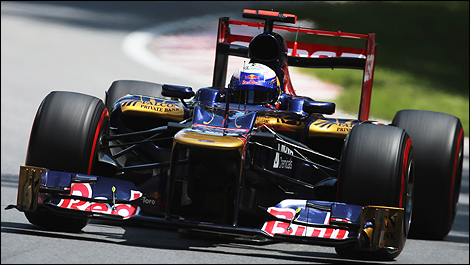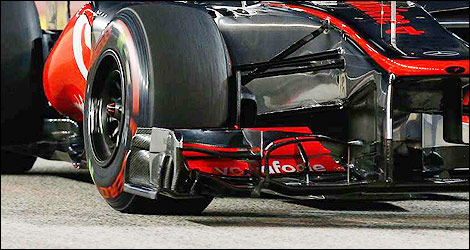Jan
7th
Stay connected Subscribe to our RSS feed
The FIA has introduced a series of small but crucial changes to the Formula 1 rules and regulations. Let's review what's new for 2013.
From Formula1.com
DRS use
For safety reasons, in 2013 drivers are only be able to utilise the Drag Reduction System (DRS) overtaking aid within the designated DRS zones during practice and qualifying. Previously drivers had been free to deploy the system as they pleased in these sessions.
Active double-DRS systems outlawed
In 2012 Mercedes developed a clever concept whereby air was channelled through an opening in the rear-wing endplate when DRS was activated and then fed through the car to help stall the front wing. For 2013 active drag reducing systems involving the DRS, such as this, have been banned.
Stepped noses
Teams have the option of tidying up the aesthetics of their cars in 2013 with the introduction of new regulations aimed at improving the look of ‘ugly' stepped noses first seen in 2012. A small piece of laminate - nicknamed a ‘modesty' or 'vanity' panel - may now be used to smooth the nose section.
Crash testing
To make F1 cars ever safer, tougher new tests on roll structures and the survival cell have been introduced for 2013. Furthermore, every chassis that a team produces, as opposed to just one, will now be subject to a static load test of the survival cell.
Curfews
The team personnel curfew - which prevents team members from being in the paddock during specified periods - has been extended from six to eight hours on Thursday nights for 2013. The number of exceptions allowed during a season has also been reduced from four to two.
Front wing tests
For 2013 front wing deflection tests will be more stringent to lessen the possibility of flexible bodywork being used to enhance aerodynamic performance.
Minimum weight
The minimum weight of the car and driver has been increased from 640kg to 642kg to compensate for the slightly increased weight of Pirelli's 2013 tires. The mandatory weight distribution has also been adjusted accordingly.
Force majeure
The ‘force majeure' allowance relating to when a car stops on the track during qualifying has been deleted from the regulations. For 2013 any car that stops on the track must have enough fuel for the mandatory one-litre minimum sample plus an additional amount proportional to the amount of fuel that would have been used in returning to the pits (determined by the FIA).
Qualifying
Not an actual regulation change, but as the official 2013 entry list comprises 22 cars - two fewer than in 2012 - six cars rather than seven will now be eliminated at the end of both Q1 and Q2.
Championship entry fees
Championship entry fees have been revised. Red Bull, as constructors' champions, were required to pay US$500,000 plus US$6000 for each point gained in the 2012 World Constructors' Championship to enter the 2013 championship. Every other team was required to pay a basic fee of US$500,000 plus US$5000 for each point scored in 2012.
From Formula1.com
DRS use
For safety reasons, in 2013 drivers are only be able to utilise the Drag Reduction System (DRS) overtaking aid within the designated DRS zones during practice and qualifying. Previously drivers had been free to deploy the system as they pleased in these sessions.
 |
| Photo: WRi2 |
Active double-DRS systems outlawed
In 2012 Mercedes developed a clever concept whereby air was channelled through an opening in the rear-wing endplate when DRS was activated and then fed through the car to help stall the front wing. For 2013 active drag reducing systems involving the DRS, such as this, have been banned.
Stepped noses
Teams have the option of tidying up the aesthetics of their cars in 2013 with the introduction of new regulations aimed at improving the look of ‘ugly' stepped noses first seen in 2012. A small piece of laminate - nicknamed a ‘modesty' or 'vanity' panel - may now be used to smooth the nose section.
Crash testing
To make F1 cars ever safer, tougher new tests on roll structures and the survival cell have been introduced for 2013. Furthermore, every chassis that a team produces, as opposed to just one, will now be subject to a static load test of the survival cell.
Curfews
The team personnel curfew - which prevents team members from being in the paddock during specified periods - has been extended from six to eight hours on Thursday nights for 2013. The number of exceptions allowed during a season has also been reduced from four to two.
Front wing tests
For 2013 front wing deflection tests will be more stringent to lessen the possibility of flexible bodywork being used to enhance aerodynamic performance.
 |
| Photo: WRi2 |
Minimum weight
The minimum weight of the car and driver has been increased from 640kg to 642kg to compensate for the slightly increased weight of Pirelli's 2013 tires. The mandatory weight distribution has also been adjusted accordingly.
Force majeure
The ‘force majeure' allowance relating to when a car stops on the track during qualifying has been deleted from the regulations. For 2013 any car that stops on the track must have enough fuel for the mandatory one-litre minimum sample plus an additional amount proportional to the amount of fuel that would have been used in returning to the pits (determined by the FIA).
Qualifying
Not an actual regulation change, but as the official 2013 entry list comprises 22 cars - two fewer than in 2012 - six cars rather than seven will now be eliminated at the end of both Q1 and Q2.
Championship entry fees
Championship entry fees have been revised. Red Bull, as constructors' champions, were required to pay US$500,000 plus US$6000 for each point gained in the 2012 World Constructors' Championship to enter the 2013 championship. Every other team was required to pay a basic fee of US$500,000 plus US$5000 for each point scored in 2012.
 The latest auto news, reviews, prices, product and vehicle releases.
The latest auto news, reviews, prices, product and vehicle releases.